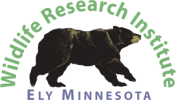Cubs, Wolves, and a Story - UPDATE October 27, 2015
 Cute cub - WRI file photoCalls and emails the last couple days were about what to do with orphaned cubs in the aftermath of Florida’s 2-day bear hunt. The cubs are nearly 9 months old. Should they be left in the wild or put in captivity? Either choice has a downside. I said I didn’t know enough about Florida bears to say for sure, but from my studies in the Great Lakes Area, they’d probably do best left alone at that age to learn the forest and be free to roam. They probably already know about snakes and alligators, although accidental deaths (not from starvation or freezing) were more common in Minnesota among orphans than cubs with their mothers.
Cute cub - WRI file photoCalls and emails the last couple days were about what to do with orphaned cubs in the aftermath of Florida’s 2-day bear hunt. The cubs are nearly 9 months old. Should they be left in the wild or put in captivity? Either choice has a downside. I said I didn’t know enough about Florida bears to say for sure, but from my studies in the Great Lakes Area, they’d probably do best left alone at that age to learn the forest and be free to roam. They probably already know about snakes and alligators, although accidental deaths (not from starvation or freezing) were more common in Minnesota among orphans than cubs with their mothers.
But what about making dens? I don’t know if they need dens in Florida. Orphans that I radio-collared in Minnesota made good dens on their own even though their mothers would normally do most of the work.
I don’t know how fat cubs should be at this time of year in Florida and what they eat in the wild overwinter. I know bears can recognize edible foods without being taught.
I know some bears slow down and spend a lot of time in surface beds there in winter, but researchers who tried to sneak close didn’t get to see them because they were alert and wary.
 Looking through birches - WRI file photoThe biggest downsides of captivity are that, depending on the captive conditions, they likely won’t learn much and boredom can lead to captive psychoses like pacing and other repetitive movements. Orphaning is a problem with bear-hunting. I’m glad I successfully fought spring hunts in Minnesota and Ontario. No orphans can survive in the wild at that time. Now Ontario is considering a spring hunt again. When they ended their previous spring hunt in the mid-1990’s, Ontario biologists estimated that 274 cubs were orphaned per hunt.
Looking through birches - WRI file photoThe biggest downsides of captivity are that, depending on the captive conditions, they likely won’t learn much and boredom can lead to captive psychoses like pacing and other repetitive movements. Orphaning is a problem with bear-hunting. I’m glad I successfully fought spring hunts in Minnesota and Ontario. No orphans can survive in the wild at that time. Now Ontario is considering a spring hunt again. When they ended their previous spring hunt in the mid-1990’s, Ontario biologists estimated that 274 cubs were orphaned per hunt.
The cub picture highlights the orphan cub topic but is not from Florida. It is a Minnesota cub from the nineties. The wolf pictures for the next topic were also taken years ago.
Also on the downer side, sensationalistic TV producers are at it again—this time making wolves look bad. I have turned down being in a number of TV programs, including one a couple weeks ago, because I suspected the program would not properly educate. It sounds like the Wolf Center tried to help make a good program by allowing their captive wolves to be filmed, only to learn now that sensationalism became a part of it. I suspect they did not know the title would be “Natural Born Monsters.”
 Wolf pup licking mother - WRI file photo“The International Wolf Center is disappointed with a TV show being aired on The Weather Channel tonight at 10:00 p.m. EST, titled “Natural Born Monsters.” Earlier today, the Center’s leadership had the opportunity to preview tonight’s episode that showcases wolves living in northern Minnesota, including footage taken onsite last winter at our Interpretive Center in Ely. In this episode, a significant number of distortions and misrepresentations are being made about wolves by the show’s host, Sean Duggan. Shows like this rely on dramatic sensationalism to boost ratings and revenue, but confuse the public and do great disservice to the many biologists, organizations, naturalists, and others who work on behalf of animals around the world.”
Wolf pup licking mother - WRI file photo“The International Wolf Center is disappointed with a TV show being aired on The Weather Channel tonight at 10:00 p.m. EST, titled “Natural Born Monsters.” Earlier today, the Center’s leadership had the opportunity to preview tonight’s episode that showcases wolves living in northern Minnesota, including footage taken onsite last winter at our Interpretive Center in Ely. In this episode, a significant number of distortions and misrepresentations are being made about wolves by the show’s host, Sean Duggan. Shows like this rely on dramatic sensationalism to boost ratings and revenue, but confuse the public and do great disservice to the many biologists, organizations, naturalists, and others who work on behalf of animals around the world.”
I don’t know if critical letters to The Weather Channel would do any good if their producers only care about ratings and revenue.
On the happy side, these pictures of a leopard seal in Antarctica make us want to know more about the feelings and thoughts of animals. http://www.rense.com/general96/diver.html
Thank you for all you do.
Lynn Rogers, Biologist, Wildlife Research Institute and North American Bear Center
